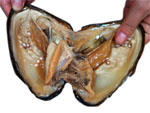
Although valued as “gemstones” pearls/moti are neither gems nor stones. They are animal in origin, and can only be produced in pearl oysters – living shelled molluscs that look like a pair of cymbals.
The pearl is not a part of any oyster’s body by birth. It is a growth that forms inside its body because of its reaction to an external irritant particle like a grain of sand which might have entered it through the gap between the pair of shells.
Such a particle causes the same irritation and stress to the oyster that dirt in our eyes causes us. It’s reaction is identical to ours: like our eyes go into a frenzy of blinking and furious batting of eyelids and try to wash away the particle by tears, similarly the oyster reacts to the particle by secreting layer upon layer of a substance called nacre upon the particle to shield itself from it, but to no avail.
In our case the irritation is temporary, for oysters endless. Day in and day out, year in and year out, the irritation progresses to trauma, pain and suffering while layers of nacre continue covering the particle and building up into a pearl.
Natural pearls are those that have occurred in wild oysters, whereas cultured pearls are those that have been engineered by humans to occur in farmed oysters. Both are the outcome of killing. In nature when grit gets embedded into an oyster’s soft body, as protection it begins covering it with nacre. A pearl is thus formed – a result of three to seven years of suffering. There is literally a one in a million chance of finding a natural pearl. From three tons of oysters, only three, or may be four produce a perfect pearl, and as many as a hundred thousand oysters could be split open and killed to produce a pearl necklace. The pearl industry massacres and discards.
99.99% of pearls sold are cultured. To obtain cultured pearls, pearl oysters are specially bred in farms. Using a pair of surgical tongs to carefully hold an oyster’s valves open, a few incisions are made in the soft body of the oyster into which a bit of shell from a freshly sacrificed oyster is grafted.
The pain on getting a splinter under our skin is very a mild form of what the pearl oyster is made to suffer. An oyster is liable to die while being incised or falling a prey to fouling and boring organisms while secreting the nacre to cover the grit.
Even if the oyster survives these two steps, it has no chance of getting through unscathed during removal of the pearls (up to 32 per creature) which can be after as long as seven years of pain and agony — only to produce a couple of culturedpearls. And, only 40% of the pearls obtained are marketable, out of which 5% turn out perfectly spherical and fetch a good price.
Removal of the pearl inside involves splitting open the pearl oyster by inserting a knife between the two valves and twisting it to cut the adductor muscle that holds the shell closed, thus effectively killing the creature… and “just too bad” if no pearl is found or has been properly formed which is more likely.
Thus each and every pearl, whether cultured or natural, represents hundreds and thousands of oyster shells being opened up and discarded, resulting in their death.
Pearl oysters that are discarded are not channelled as food because oysters are eaten alive or cooked alive. If the shell is open, the oyster is dead and is poisonous to consume.
Irrespective of the type, colour or name given to the pearls, whether natural, cultured, Hyderabad, Mandapam, or Mikimoto of Japan, ALL pearls have a hidden history of pain and killing. Even Majorica pearls of Spain termed ‘man-made pearls’ and some others called ‘artificial/fake/simulated pearls’ use fish scales and/or lustre from cultured pearls in their making.
Since 70% of pearls produced are worn as jewellery, mainly necklaces and chokers, Beauty Without Cruelty hopes that by creating an awareness that pearls and pain are synonyms, shops will give up selling pearl jewellery. Pearls can be substituted with white moonstones (chandramani) which resemble them.
Like pearls, moonstones are lustrous, glowing rather than sparkling, associated with purity and innocence. Moonstones are translucent and posses an inner lustre, whereas pearls have an opaque glow. Ancients believed moonstones to be solidified rays of the moon and that’s how the gemstone acquired its name. The moonstone plays the same role as the pearl in Indian astrological gem therapy, providing a cooling effect upon the wearer, bringing peace of mind and helping concentration. Moonstones are mined in Sri Lanka and South India and the finest ones are reminiscent of the moon.
In 2012 Beauty Without Cruelty launched a campaign against the use of pearls, as a result of which ORRA, one of the world’s leading jewellers, agreed not to sell pearls in five of their stores and display a “Pearls = Pain” poster.
BWC now looks forward to many other shops not stocking pearl jewellery and will be happy to supply display material. Please spread the word.
For detailed information on Pearls please read
http://www.bwcindia.org/Web/Awareness/LearnAbout/Pearls.html
|